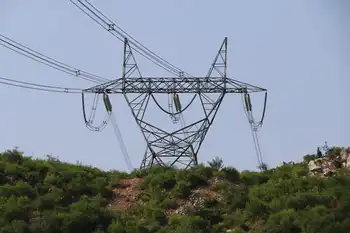High stakes at Bruce Power
By Toronto Star
CSA Z462 Arc Flash Training - Electrical Safety Essentials
Our customized live online or in‑person group training can be delivered to your staff at your location.

- Live Online
- 6 hours Instructor-led
- Group Training Available
"Welcome to the house of Count Dracula," says health physicist Maung Zeya. "Enter at your peril."
The out-of-service Candu reactor at the Bruce Power plant appears in the dingy light like a giant mechanical beehive. The air is hot and oppressive, and a handful of repairmen are at work.
Jack Rollins, a radiation official dressed head to toe in protective gear, stands 15 metres from the reactor and points a gun that detects gamma rays. It registers 18 millirems, a unit that measures the amount of radiation absorbed.
"What you see right there has already gone right through your body," says Rollins. "It's like an X-ray."
"Now watch this," he adds, moving his arm toward the reactor and noting the numbers on his gun shooting upwards.
It's an impressive display of the staying power of radiation, particularly since its source – uranium fuel bundles – was removed from the reactor 10 years ago.
But the residual dose is well below the yearly limit for Canadian nuclear workers, allowing them significant stretches of time up close to gut and renovate reactors at the Bruce A plant on the shores of Lake Huron.
The $5.2 billion project to fully refurbish four Candu reactors by 2013 is one of the biggest construction projects in Canada. Duncan Hawthorne, president and chief executive officer of privately owned Bruce Power, says the project will make or break Canada's nuclear industry.
"It's a destiny issue for the industry," Hawthorne says. "The success of this project spawns other projects and the failure of this probably means that we wouldn't want to do it again. Everybody knows what's at stake here."
Hawthorne, who also heads the North American branch of the World Association of Nuclear Operators, believes the outcome could also impact the industry in the U.S., which uses reactors other than Candus.
"If you're trying to borrow from financiers on the back of an unsuccessful project here, what are you going to say? `Well, that was Candu and it was those Canadians that don't know what they're doing?' That's not a very easy sell," he says.
The stakes are especially high in Ontario, where the Ontario Power Authority (OPA) wants to keep almost half of the province's electricity coming from nuclear plants during the next 20 years. That means spending $26.5 billion to renovate existing plants or build new ones.
Ontario's refurbishment record leaves little room for encouragement. Renovating and restarting just two Candu reactors at Pickering A, as taxpayers know, cost publicly-owned Ontario Power Generation $2.5 billion – wildly above the initial $800 million estimate to repair all four Pickering units.
But halfway through the first part of the Bruce project – a $2.7 billion plan to renovate reactors 1 and 2 – Hawthorne remains confident.
"We're on time and on budget," he says during an interview at Bruce Power's corporate offices on the sprawling nuclear site. "That's not to say that it's plain sailing. We'll have to fight our way through it."
The Ontario Power Authority, the agency that signed the much-debated contract with Bruce on behalf of the provincial government, concurs with Hawthorne's assessment.
"Our feeling is, if they're not on target, they're pretty close," says OPA spokesperson Tim Taylor.
Bolstering confidence is the fixed-price contracts Bruce Power signed with most of the contractors. Still, critics well versed with the Pickering refurbishment fiasco roll their eyes at early talk of success.
"The Candu is a bad design – it's a nightmare. The sooner we get rid of it the better," says Frank Greening, who examined weaknesses in the Candu's pressure tubes and feeder pipes while a senior chemist at OPG.
"Refurbishing old Candus is throwing money down a black hole," he adds, describing continued faith in the technology as "Canadians being pigheaded about a Canadian product that was good at one time but now is a lemon."
Critics note that OPG permanently mothballed two Pickering A reactors in 2005 because they were not worth fixing. The other two, which cost a fortune to renovate, have performed poorly since restarting in 2003 and 2005, and were shut down all summer for maintenance.
"The test is, do the (Bruce) units come on line on budget and on time, and how long do they stay on line?" says Mark Winfield, assistant professor of environmental studies at York University. "The record so far does not inspire confidence, to put it mildly."
The Bruce nuclear site is a heavily guarded, 932-hectare complex 250 kilometres northwest of Toronto. It has two nuclear plants – Bruce A and B – each with four Candu reactors, ranging from 750 megawatts to 822 megawatts.
The six working reactors produce about 20 per cent of Ontario's electricity. When all eight are back on-line, the site's total output will be 6,200 megawatts, about 25 per cent of the province's power.
Burdened by debt, and with its nuclear program in disarray, OPG's precursor, Ontario Hydro, began shutting nuclear reactors in the late 1990s, including the four at Bruce A.
In 2001, OPG signed a long-term lease for the Bruce site with Bruce Power, a consortium today made up of uranium producer Cameco Corp., TransCanada PipeLines, the plant's two main unions, and BPC Generation Infrastructure Trust, owned by the Ontario Municipal Employees Retirement System.
By 2005, the consortium had restarted Bruce A reactors 3 and 4, a $720-million renovation project that Bruce initially thought would cost $340 million. Bruce officials blame the cost overrun, picked up wholly by the consortium, largely on security improvements imposed by the Canadian Nuclear Safety Commission after the 9/11 attacks in the U.S.
But Hawthorne makes clear there was more to it than that: "These are complicated animals to restart... restarting reactors is tough."
Also that year, Bruce Power sealed a deal with the provincial government to refurbish and restart three Bruce A reactors, and expanded it this summer to fully renovate the fourth.
Ontario's increased need for power, coupled with the Liberal policy to phase out polluting coal-burning power plants, put the government in a weak negotiating position, according to an April report on the deal by provincial Auditor General Jim McCarter.
When subsidies are factored in, such as a rent reduction for Bruce Power and the government paying for Bruce's uranium fuel, the consortium is guaranteed between 6.3 and 7.1 cents per kilowatt hour for its electricity, McCarter concluded. That's well above the 4.9 cents average for the past five years and significantly above what private-sector experts believe the future price of electricity will be, he added.
"There's a definite cost to doing this sort of deal with the private sector," McCarter says in an interview, adding that the price of Bruce electricity will also increase annually, based on inflation.
"Consumers, you've got to be prepared. Your electricity bills are going up, and they're going up by a pretty healthy amount," he says.
Hawthorne is the poster boy of a beleaguered nuclear industry. After a decade of bad press from Ontario Hydro and OPG debacles, the industry rallied around the Porsche-driving nuclear executive with a Scottish accent. A framed picture in the reception area of his office shows him cradling an unused nuclear fuel bundle in his arms.
He doesn't hesitate to lambaste what he describes as a non-existent conservation culture – "We're a backwards province and a backwards country" – and sharply criticizes Canadian governments for what he says are their abysmal investments in research and development.
He's convinced he's at the forefront of a resurgent nuclear industry, dismissing worldwide examples to the contrary — a German law to phase out nuclear plants and an Italian moratorium on building new ones, to name only two — as temporary sops to public opinion.
"I'm not for nuclear world domination, I'm just recognizing that nuclear is a very significant part of the mix," says Hawthorne, whose consortium is also studying the building of new nuclear plants on the site.
He's equally convinced Bruce can avoid OPG's flawed record of refurbishing Candus or making them work at full capacity.
He suspects a lot of OPG's troubles involved a dysfunctional workplace culture.
He describes the collective agreement Bruce Power inherited as "the thickest you would find anywhere," a result, he believes, of a workplace where "no one trust(ed) anyone."
During a general meeting with employees, Hawthorne says he announced: "If I believe what I hear, I should sack all the managers for being incompetent and sack all you guys for being lazy. I don't believe any of that, and we've got to find a way to change that culture."
In the past, the plant's performance was also badly hit by poor management and a lack of best industry practices that prolonged maintenance when reactors unexpectedly shut down, Hawthorne says. Since Bruce Power took over, technical staff has been completely retrained.
"I know it's a tough project but we're just going to go on and get it done," he says, referring to the refurbishment. "I'd rather take the chance to fail than sit here in the wings without the opportunity."











